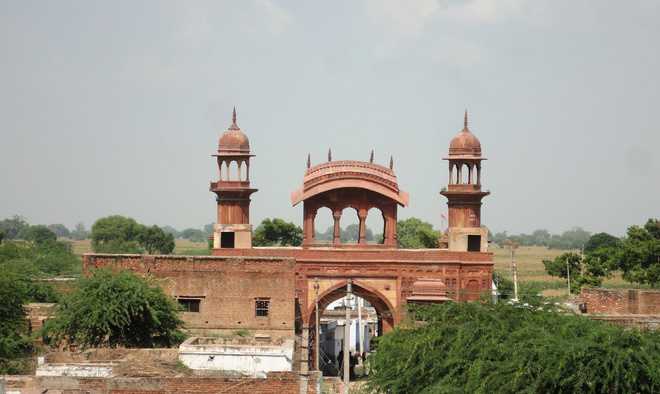A dilapidated Mughal serai and its regal past
Ragini Puri
Cruising down the smooth roads of National Highway 3 from Agra towards Gwalior, a hazy silhouette of minarets on the right side of the stretch near Dholpur breaks the monotony of a bland landscape. Focus hard against the glaring sun and the silhouette fades away, giving way to a sharp image of slightly red sandstone minarets that hint at being part of a magnificent structure.
Up close, the minarets look stately, part of a towering gateway standing grand amidst a cluster of whitewashed brick and plaster houses. Conversations with the curious onlookers from around the settlement reveal that the structure indeed has a regal past, having been built during Aurangzeb’s reign. Estimated to be around 500 years old, the minarets are the remnants of a grand caravan serai (rest house) constructed by the Mughals in the early 1600s.
Given their penchant for long journeys across their acquired territories, the Mughals built a number of serais to rest while travelling. These serais or motels as we might classify them today also served as rest spots for the travelling caravans of traders, merchants and Mughal soldiers. The historic Grand Trunk Road is dotted with the ruins of several such serais, and this was one such campsite, built on the highway that led to Mughal territories down south.
The gateway seen from the highway is a part of two identical gateways of the serai complex. The second one is towards the other end of the complex, close to the Gambhir river (also called Utangan river) that irrigates the farmlands around the serai. Both these gateways are artfully designed three-storeyed structures, with airy rooms and balconies that face the interiors of the complex and perhaps helped keep an eye on the goings-on inside the serai. The walls are decorated with arabesque motifs and carvings typical of the early Mughal architecture.
Typical of most such constructions, the layout plan of this serai too had a large open courtyard with rooms around the peripheral wall. All of it is gone now, with the land encroached upon by the settlers who have built houses inside the once-walled complex. What remains besides the gateways is a three-domed mosque, which is still in use by the locals.
Walking around the serai, with the curious kids from the neighbourhood joining in, the exploration soon turns into a walking tour with random hearsay information flying freely. Once every nook and corner of the serai is explored, the giggly bunch of kids suggests the baoli (step-well) nearby be explored too.
The step-well, the construction period of which dates back to the same era as that of the serai, looks grand but has been turned into a storage barn by the villagers. Clumsily stocked stacks of hay and scrubby overgrowth mar its beauty, but at the same time add an air of mystery to the forlorn looking structure. The sheen of the red sandstone speaks of better days, but it is in need of some sprucing up now. The locals are indifferent, for heritage conservation does not figure in their scheme of things. Of course, keeping up with the elementary needs of life are a bigger priority.
Climbing down to the bottom of the three-storeyed step-well, the chit-chat with the kids turns towards the importance of protecting and preserving our heritage and the young ones promise to keep both the heritage structures clean and protected from nitwits who deface the walls of public monuments with ugly graffiti. With this promise, it is time to say goodbye to Jajau serai. The short stopover serves as a delightful insight into the caravan serais of the Mughal era. Hope the striking minarets continue to intrigue and beckon curious travellers to appreciate their bustling past.










